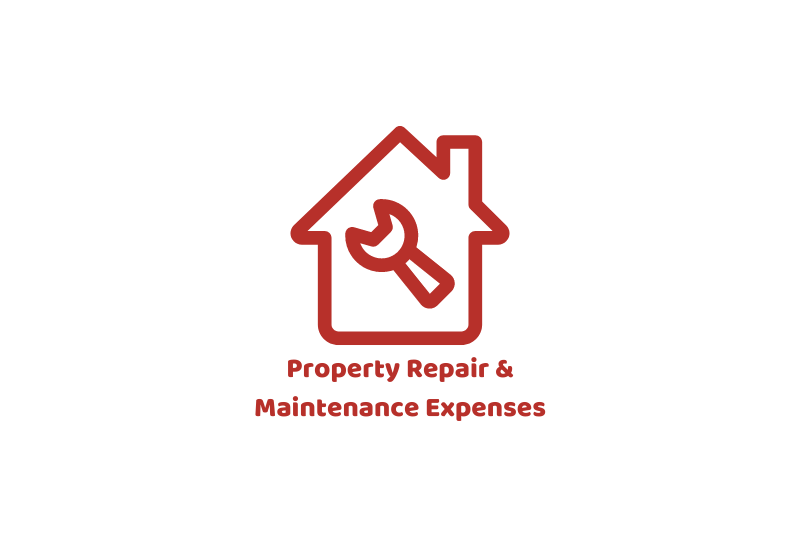What do we actually mean when we say property repair and maintenance expense? Repair means the restoration of an asset by replacing subsidiary parts of the total asset. An example is a cost of replacing roof tiles blown off by a storm. There won’t be a repair if a significant improvement of the asset beyond its original condition results – in capital expenditure.
For instance, there will be a capital improvement if the taxpayer takes off the roof and builds on another storey.
Looking for a qualified accountant, get in touch with us!
A repair is usually a revenue expense that can be deducted in computing rental business profits. Capital expenses are generally not deductible in computing profits. There was a limited concession for ‘notional repairs’, which ceased to have effect from April 2001 (see below). Allowances are available for certain kinds of capital expenses, such as the expense of constructing or extending industrial buildings.
To make it clearer we will give you examples of property repair and maintenance expenses or you can just contact our accountants.
Examples of Property Repair & Maintenance Expenses
Examples of common property repair and maintenance expenses that are generally deductible in computing rental business profits include:
- exterior and interior painting and decorating,
- stone cleaning,
- damp and rot treatment,
- mending broken windows, doors, furniture, and machines such as cookers or lifts,
- re-pointing, and
- replacing roof slates, flashing, and gutters.
This guidance applies equally to CT Schedule A from 1 April 1998.
Further guidance is given in an article in TB59 issued in July 2002. Entitled ‘Schedule A: computation of profits: repairs to property’. This is reproduced at the end of this page.
Accotax is providing affordable accounting, bookkeeping, and taxation services to contractors. Get an instant quote now!
The cost of land and buildings in the capital
The cost of land and any buildings on it is capital expenditure. So is the price of any new buildings erected after letting has started and any improvements. Capital expenditure cannot be deducted in computing the profits of a rental business. Revenue deduction cant is claimed for the depreciation of capital assets or for loss on disposal of capital assets. But there are separate reliefs for some capital expenditure (see below).
Other examples of capital expenses include:
- expenditure which adds to or improves the land or property; for example, converting a disused barn to a holiday home,
- the cost of refurbishing or repairing a property bought in a derelict or run-down state,
- expenditure on demolishing an abandoned factory to clear space for a new office building; the cost of the new building,
- the cost of building a car park next to a property that islet,
- expenditure on a new access road to a property,
- the price of a new piece of land next to a property that is made.
Separate relief for capital expenses
In some cases, capital expenditure on a property (not the land itself) may qualify for ‘capital allowances’‘. These are effectively further deductions in arriving at a taxable rental business profit. In particular, capital allowances are available for expenditure on individual industrial and agricultural buildings. Plant or machinery within premises may qualify, for example, lifts. Benefits may also be due to demolition costs. There are no capital allowances for the value or depreciation of residential property; but a ‘wear and tear’ compensation may be expected for the plant and machinery (furniture, furnishings, etc.) within furnished accommodation ( PIM3200). An allowance may also be due for the cost of installing loft, cavity wall or solid wall insulation, draught-proofing, or insulation for hot water systems in a residential property that is let ( PIM2050).
There is more about relief for capital expenditure at PIM3000 onwards.
When there is a capital improvement
It is mostly a question of fact in each case whether the repair and maintenance expenses list on a property leads to an improvement.
Sometimes the improvement may be so small as to count as incidental to a repair. In the absence of other capital indications, the entire cost is then revenue expenditure.
Problems can arise where the taxpayer does work on an old asset. A repair or replacement of a part of a building using modern materials may give an apparent element of improvement because of the more exceptional durability, superior qualities, and so forth of the new content. But the cost remains typically revenue expenditure where any development arises because the taxpayer uses modern materials that are broadly equivalent to the old stuff.
Example
For example, the following are usually revenue expenses on property repairs and maintenance in the absence of any other capital indications. The cost of replacing:
- wooden beams with steel girders, and
- lead pipes with copper or plastic pipes.
There is likely to be capital expenditure if, say, the steel girders were designed to take heavier loads so that the building could take larger machines after the work was done. The same is true if the new pipes are designed to bring enormous pressure or heat.
But there is usually no improvement if small increases in performance or capacity arise solely from the replacement of old materials with newer but broadly equivalent materials. For example, the substitution of pipes or storage tanks of imperial measures with the closest metric equivalent may result in slightly increased diameter or capacity, but the cost is still revenue expenditure.
Where a significant improvement arises from the change of materials, the whole of the cost is capital expenditure. This includes things like redecoration after the main work has been done (redecoration would ordinarily be a revenue expense). The entire fee is capital expenditure, including the cost of making right any damage to decorations.
Extensive alterations to a property
Alterations to a building may be so extensive as to amount to the reconstruction of the property. This will be capital expenditure, and it can’t be deducted as an ordinary revenue business expense. Rebuilding, whether forced on the taxpayer or voluntarily undertaken, is capital expenditure and the total cost can’t be deducted in computing profits. Only the actual cost of standard revenue repairs to a part of the old building that is preserved in the rebuilt structure is allowable as an ordinary revenue business expense. But:
- capital expenditure may instead qualify in some instances for capital allowances (seePIM3000 onwards), or
- the whole of payment is not necessarily either capital or revenue; it may be possible to split it between capital and revenue items – see below.
Capital work and revenue repairs at the same time
Work commissioned on a property may include expenditure on capital works and also separate expenditure on repairs at the same time. Here the cost of repairs remains allowable. Price may be apportioned on a reasonable basis to estimate the amount attributable to the repair element. Apportionment in the contractor’s bill may provide a rational basis for splitting the total; but it must be done fairly, and the figures will be open to review if, say, capital expenditure is wrongly described as revenue expenditure on repairs.
Are you struggling to reduce your Capital Gains Tax, we’d love to help, do let us know!
Repairs etc. after a property is acquired.
Repairs to reinstate a worn or dilapidated asset are usually deductible as revenue expenditure. The mere fact that the taxpayer bought the asset not long before the property repairs and maintenance are made does not in itself make the replacement a capital expense. But a change of ownership combined with one or more additional factors may mean the expenditure is capital. Examples of such factors are:
- A property acquired that wasn’t in a fit state for use in the business until the repairs had been carried out or that couldn’t continue to be let without repairs being made shortly after acquisition.
- The price paid for the property was substantially reduced because of its dilapidated state. A deduction isn’t denied where the purchase price merely reflects the reduced value of the asset due to normal wear and tear (for example, between regular exterior painting cycles). This is so even if the taxpayer makes the repairs just after they acquire the asset.
- The taxpayer makes an agreement that commits them to reinstate the property to a good state of repair. For example, Fred is granted a 21-year lease of a property in a poor state of repair by his landlord that he, in turn, sublets. When Fred’s landlord allows him the contract, Fred agrees that he will refurbish the property. Fred’s expenditure on making good will be capital expenditure and not allowable. But Fred’s landlord may be chargeable on the value of the work under the rules of the premium ( PIM1200 onwards), and Fred may qualify for some relief (see PIM2300 onwards). See below if payments for dilapidations are made to the landlord at the end of the lease.
Cost of buying a property in good condition
All these factors don’t need to be present for the expenditure to be capital. The underlying principle is that the cost of buying a property in good condition is capital expenditure. Hence the cost of buying a dilapidated property and putting it in good order is also capital expenditure.
Where the taxpayer is granted a lease of a property in good repair, the expenses they incur in keeping it in that state will generally be deductible. This usually includes a payment they make to their landlord at the end of their lease on account of repairs that were due but which they had not made. These over-due repairs are called ‘dilapidations’.
Provisions for repairs to premises
A taxpayer can deduct expenditure on repairs where the liability to pay for the work is incurred during the tax year, but payment has not been made by 5 April. But a provision for repairs to premises that they propose to bear in the future is not deductible. For example, they can’t claim a deduction for repair work they think will need doing next year but which they have not yet incurred any liability to pay.
Repairs to assets on which capital allowances were claimed
The taxpayer’s right to a repairs deduction is not lost because they had, or are getting, capital allowances on the asset as a whole.
For example, suppose the taxpayer replaces a chimney that is a natural part of a factory building. This is usually a revenue expense where the new vent is a repair to the factory; there is no improvement – the factory was not bought in a dilapidated state. If it is a repair, the taxpayer can deduct the cost even though the industrial buildings allowance was due to the value of constructing the factory.
No further capital allowance is due to the repair expenditure if it qualifies as a revenue expense. On the other hand, if the spending on the new factory chimney is capital expenditure, the taxpayer may be able to claim industrial buildings allowance on it.
Grants received
Generally, any grants the taxpayer gets towards, say, the cost of revenue expenditure on repairs must be included in their rental business profits. Grants towards capital expenditure must similarly be deducted in arriving at the spending that qualifies for capital allowances.
Timing of deduction
The standard trading income rules apply (with the exception of ESC/B4 which used to Schedule A property income but not to trading income until April 2001 – see below). For further guidance, see BIM46901.
Repairs covered by insurance
The landlord may have an insurance policy that covers the cost of some property repair & maintenance expenses repairs. You should allow as a deduction only the excess of the price over the amount of the insurance recovery. Sometimes this is achieved in accounts by deducting the expense when it is incurred, and crediting the insurance recovery as a receipt when it is received. You may accept this approach. (We adopt similar principles for traders – see BIM40755.)
Tenants’ contributions to maintenance costs
ICTA88/S24 (6) (b) and ITTOIA05/S266 (2) provide that ‘rents’ includes payments by the tenant for work to maintain or repair leased premises which the lease does not require the tenant to carry out.
Where a tenant is required to make such contribution, therefore, the amounts received by the landlord are taxable in full. The cost of repairs is allowable in full. It is incorrect to set one off against the other, and the correct treatment may produce a different result (as the repairs expenditure may well be incurred in a later chargeable period).
Where the tenant’s contributions are paid into a trust fund, see PIM1070.
Dilapidations
The landlord of a property let on tenants repairing lease usually inspects the property before the rent is due to expire and may send the tenant a list of repairs which should have been carried out under the terms of the lease but which have not, in fact, been done. Instead of doing the repairs, the tenant may make a payment to the landlord.
- Where the landlord then disposes of the property or occupies it himself, the payment is likely to be treated as a capital receipt by way of compensation for failing to observe the terms of the lease as a result of which the property reverted to the landlord in a dilapidated condition. The sum paid to the landlord may then be chargeable, in his hands, to CGT.
- Otherwise, the payment is likely to have the effect of filling a hole in the landlord’s profits (i.e. compensation for the lower rent the property can now command), and the payment should be treated as a receipt of the rental business. The Privy Council case in 1976 of Raja’s Commercial College v Gian Singh supports the view that, for a rental company, it is appropriate to treat such receipts as taxable because they plug a hole in the landlord’s income as opposed to the landlord’s capital.
Alternatively, the tenant may pay a sum towards the cost to the landlord of carrying out the repairs required. In that case, the landlord should only get a deduction for the net value he bears.
Improvements to property and’ notional repairs’: ESC/B4: periods to April 2001
An alteration may not amount to a reconstruction of the whole property, but the expenditure may still be capital expenditure because there is an improvement to the property.
For periods up to April 2001, ESC/B4 gave a measure of revenue relief where capital improvement expenditure saved the need for repairs expenditure. That is, either repairs to the old fittings were avoided or, but for the installation of improved accessories, expenditure on equivalent replacements would have been needed. ESC/B4 permits a deduction for the part of the capital expenditure that saves the estimated cost of the repair that would otherwise have been needed.
Another example is the cost of alterations made to reduce fire risks, perhaps to satisfy a local fire authority. Expenditure incurred on additional exits or fire escapes does not of itself qualify as a revenue deduction, but the work may have obviated the need for some repairs. (Plant and machinery capital allowances may also be available for certified fire safety expenditure incurred on hotels and boarding houses.)
Where the alterations are so extensive as to amount to the reconstruction of the property, only the actual cost of repairs to any part of the old building incorporated in the new may be allowed. The cost of notional repairs (for example, decorations) on the further alterations isn’t deductible.
Notional repairs deduction: ESC/B4
The current property income rules, which apply from 6 April 1995 onwards, brought the IT computational rules for income from the property more into line with the computational rules for calculating trading income. ESC/B4 ceased to have effect from April 2001, (see press release PR33/98).
The notional repairs concession only applied to the computation of rental business profits. It did not apply to the calculation of trading profits.
TB59 Schedule A: computation of profits: repairs to let property
Following the withdrawal, from April 2001, of ESC/B4 (maintenance and repairs of property obviated by alterations, etc.: Schedule A assessments) we have been asked for more guidance on what constitutes an allowable repair for Schedule A purposes.
Background: computation of Schedule A profits
New rules for computing the profits of a Schedule A business were introduced by FA95 for individuals and by FA98 for companies. Broadly speaking, the earnings of a Schedule A business are now computed in the same way as the profits of a trade. This means that the starting point for the computation is a set of accounts drawn up in accordance with generally accepted accounting practice. The profit or loss shown by the reports is then subject to any adjustments required or authorised by law.
In particular small cases, the ‘cash basis’ can be used as an alternative to the ‘earnings basis’. The circumstances are set out in PIM1101.
Whatever basis is used the accounts have to be examined to see whether or not any expenditure falls to be excluded by specific tax legislation as explained in the relevant case law. Broadly speaking expenses are allowable provided they are incurred wholly and exclusively for the purposes of a Schedule A business and are not a capital expenditure.
This article clarifies what type of expenditure on building work undertaken on a let property is allowable and what is not.
Capital expenditure
The cost of the house or block of flats that is being let is capital expenditure. So is the price of any additions or improvements. So if you add to the premises, something that was not there before. Like you build an extension or a new porch, this is capital expenditure. It does not matter how small the addition is. If you add an extractor fan or fit an additional cabinet in the bathroom or kitchen. This is also considered a capital expenditure.
A landlord is likely to incur capital expenditure before a property is let for the first time or between lettings. For example, the landlord may decide to improve the property by creating ensuite facilities where there were none before. This is a capital expenditure.
Repairs to let property
To decide whether expenditure incurred on repairs to the property is allowable. The first step is to identify the ‘entirety’ that is being repaired. The doctrine of the ‘entirety’ has been well summarised by Buckley, LJ in Lurcott v Wakeley (1911) AER 41 as follows:
” Repair is restoration by renewal or replacement of subsidiary parts of the whole. Renewal, as distinguished from repair, is reconstruction of the entirety, meaning by the entirety not necessarily the whole, but substantially the whole subject matter under discussion… it follows that the question of repair is in every case one of degree, and the test is whether the act to be done is one which in substance is the renewal or replacement of defective parts or the renewal or replacement of substantially the whole.”
In the case of residential accommodation. We accept that the ‘entirety’ will generally be the house or the block of flats that islet. So if your roof is damaged and you replace the damaged area, your expenditure is allowable.
Even if the repairs are substantial, that does not of itself make them capital for tax purposes, provided the character of the asset remains unchanged. For example, if a fitted kitchen is refurbished the type of work carried out might include the stripping out and replacement of base units, wall units, sink etc., re-tiling, worktop replacement, repairs to floor coverings and associated re-plastering and re-wiring. Provided the kitchen is replaced with a similar standard kitchen then this is a repair, and the expenditure is allowable.
Repairs
If at the same time additional cabinets are fitted, increasing the storage space, or extra equipment is installed. This element is a capital addition and not allowable (applying whatever apportionment basis is reasonable on the facts). But if the whole kitchen is substantially upgraded, for example, standard units are replaced by expensive customised items using high-quality materials.
The entire expenditure will be capital. There is no longer any relief for ‘notional repairs’, which is the notional cost of the repairs that would otherwise have had to be carried out.
What we regard as a repair will necessarily change with the time to reflect technological improvements. This issue was considered in the tax case Conn v Robins Brothers Ltd [1966] 43TC266. We accept that the replacement of a part of the ‘entirety’ with the nearest modern equivalent is allowable as a repair for tax purposes and not disallowable as improvement expenditure.
An example is a double-glazing. In the past, we have the view that replacing single-glazed windows with double-glazed windows is improvement therefore, capital expenditure. But times have changed. Building standards have improved, and the types of replacement windows available from retailers have changed. We now accept that replacing single-glazed windows by double-glazed equivalents counts as allowable expenditure on repairs.
Generally, if the replacement of a part of the ‘entirety’ is like-for-like or the nearest modern equivalent. We accept the expenditure is allowable revenue expenditure.
Contact us anytime, we’ll get back to you in the shortest time possible!
Further guidance
For more detailed guidance on property repair & maintenance expenses, see BIM35450, BIM35460, BIM35465, and BIM46900 onwards.
Courtesy – HM Revenue & Customs
Are you looking for a tech-savvy accountant who doesn’t bore you with finance details? Let our accountants in London make things easier to understand for you. Accotax is friendly, proactive, young, and keeps up with all the latest developments in your business to make sure you’re on top of your game.





















































